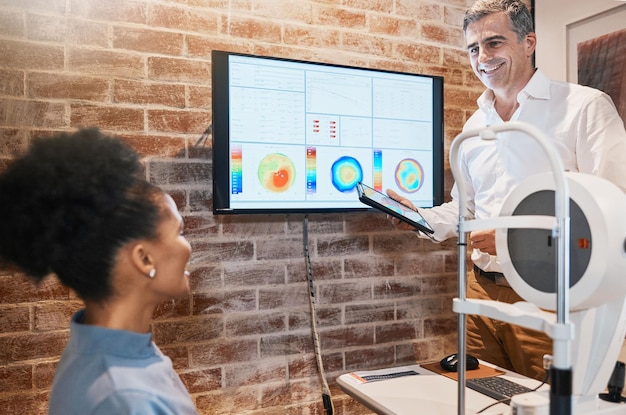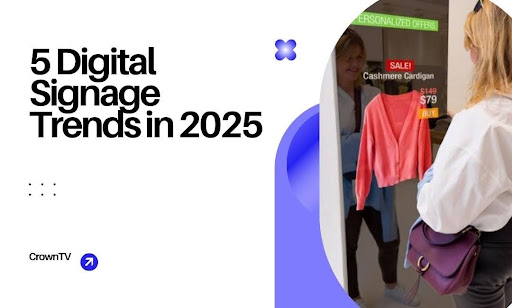What if the screen on your wall could think for itself? What if it could adjust content automatically, respond to customers in real-time, or help your team work smarter without lifting a finger? Digital signage isn’t stuck in the past anymore. The static slideshow days? Done. In 2025, screens are learning, reacting, adapting—and doing it fast. And that’s exactly what we’re digging into here.
Let’s get one thing out of the way: digital signage has quietly become one of the most underrated tech moves for businesses of all sizes. It’s no longer reserved for flashy retail chains or stadium-sized budgets. It’s smarter. Cleaner. More affordable. And it’s picking up speed in places you wouldn’t expect.
So, what’s actually changing this year? What trends are worth your attention—and which ones can actually move the needle?
In this article, we’re unpacking the 5 digital signage trends that are set to reshape how businesses operate in 2025:
- AI-powered content automation and personalization
- Integration with AR/VR and interactive experiences
- Rise of green, energy-efficient digital signage
- More affordable high-brightness displays for small businesses
- Increased adoption in non-traditional industries
By the time you’re done, you’ll know what’s hype and what’s helpful—and exactly how to put these trends to work. No fluff. No guesswork. Let’s cut through the noise.
AI is Taking Over the Screen (and That’s a Good Thing)
Digital signage no longer needs a babysitter. Manual scheduling? Gone. Static playlists? Irrelevant. In 2025, the smartest screens build their own content lineups based on data—and keep refining it without being told to.
This isn’t about tossing trendy buzzwords into your signage strategy. This is about removing guesswork from the equation and letting automation do the heavy lifting.
What’s Changing?
AI in digital signage used to be clunky—more bark than bite. But now? It’s pulling data from multiple sources in real time and adjusting messaging on the fly.
Think:
- Weather-based promos that change as the temperature drops
- Menu boards that push high-margin items based on the time of day
- Screens that recognize repeat customers and tailor messaging to past behaviors
We’re seeing a clear shift from “showing content” to serving the right message at the right moment.
Why It Works
A study found that 91% of consumers are more likely to shop with brands that recognize and remember them with relevant offers. Digital signage driven by artificial intelligence taps into that exact desire—without being invasive.
It reduces content fatigue. It keeps messaging fresh. It adapts based on time, behavior, even store traffic. And it does all of that without someone needing to micromanage the schedule.
Where to Start
If you’re still updating screen content manually, it’s time to hand off that chore. Look for platforms that:
- Use machine learning to automate scheduling
- Pull data from your POS, CRM, or weather API
- Offer dynamic templates that shift based on conditions
Pro tip: Before automating anything, map out your core content goals. AI is only as smart as the direction you give it.
AI isn’t replacing marketers. It’s giving them a sharper tool. Let this future of digital signage tech handle the heavy lifting—so you can focus on strategy instead of screen babysitting.
AR, VR, and Touchscreens Are Rewriting the Playbook

Screens aren’t just for display anymore. They’re starting conversations. Pulling data. Reacting to movement, location, and even facial cues.
That shift is being driven by a tighter integration between digital signage, AR (augmented reality), VR (virtual reality), and interactive tech—especially across retail, healthcare, real estate, and education sectors.
The goal? Stop pushing content at people and start pulling them into it.
Let’s Get Technical
At its core, this trend hinges on sensor-rich environments and context-aware computing. Screens are connecting with depth cameras, LIDAR, RFID readers, and mobile APIs to shape messaging in the moment.
Here’s what that looks like under the hood:
- AR overlays triggered by smartphone proximity or gestures
- VR-ready displays that sync with headsets or mobile apps to extend the experience
- Touchless interaction models using motion sensors or voice triggers
- Data feedback loops that capture on-screen interactions and push them into analytics stacks or CDPs
Behind every “wow” moment is a highly integrated backend: A digital signage CMS that connects with device-level SDKs, supports real-time rendering, and pulls from 3D asset libraries or WebXR frameworks.
These setups require careful bandwidth management, GPU-aware playback, and screen hardware with low-latency processing—especially when layering multiple interactive formats in high-traffic zones.
Use Cases That Actually Work
Let’s cut through the fluff. Here’s how teams are applying this right now:
- Retail: Virtual try-on mirrors that use AR to display clothing options, then sync with loyalty data to recommend size or styles
- Healthcare: Interactive screens in waiting rooms that guide patients through check-ins or display dynamic info based on appointment type
- Real Estate: VR-powered screens at property kiosks that let users “walk through” a home using only their phone or a basic headset
- Education: Touchless smartboards that adapt lessons based on student interaction or feedback
What ties these together? The screen is no longer passive. It’s spatially aware, input-sensitive, and fully programmable.
What You Need to Build This
This isn’t plug-and-play—yet. Building interactive signage that integrates AR or VR calls for:
- Hardware with camera and sensor support (or compatibility with external triggers)
- Flexible CMS that can ingest external data, APIs, or WebAR/WebXR assets
- Software dev support (or off-the-shelf widgets that support touch/gesture)
- Content teams that can produce layered visuals optimized for real-time rendering
Latency, screen refresh rate, and backend architecture matter more here than in traditional signage. Without that, interactions fall flat or frustrate users.
This is more than “interactive content.” It’s a system-level shift. And teams that put in the work up front are already seeing better engagement, cleaner data, and more meaningful user actions. It’s not a gimmick. It’s a new input layer—and it’s rewriting how we use digital displays altogether.
Energy Costs Are Forcing Smarter Screen Decisions
Electric bills are no longer a footnote in signage strategy. They’re a line item that gets flagged—especially when screens run 24/7.
This has pushed energy efficiency from a “nice-to-have” to a core buying trigger. Businesses are rethinking hardware, software, and placement not just for performance, but for power usage. And in 2025, those shifts are showing up across the board.
What’s Fueling the Change
Today’s energy-efficient digital signage isn’t about dimming brightness or setting timers. It’s driven by smarter screens, smaller processing footprints, and more intelligent display logic.
You’ll see this in:
- LED-backlit panels with local dimming zones
- System-on-chip (SoC) players that replace bulky external media boxes
- Auto-brightness sensors that adjust output based on ambient light
- Low-power standby modes that keep screens off until triggered by motion
Combined, these features cut power draw significantly without affecting clarity or speed.
On the software side, we’re seeing new CMS platforms prioritize power scheduling, automated shutdowns, and analytics that track energy consumption at scale. That visibility matters, especially for multi-location networks under pressure to hit internal sustainability targets.
Hardware Is Catching Up
Until recently, energy-efficient signage meant compromising on brightness or lifespan. That’s changed. Manufacturers are shipping displays that:
- Run cooler without fans (reducing mechanical wear)
- Use fewer components (shrinking environmental impact)
- Offer longer uptimes with less wattage per square inch
There’s also growing interest in e-paper and reflective LCD tech for low-motion applications like transit schedules or building directories—places where backlighting isn’t needed but visibility still matters.
Why It Pays Off
Electricity rates aren’t trending down. In 2025, commercial power costs in parts of the U.S. have crossed $0.20 per kilowatt-hour—especially in high-demand states like California, New York, and Hawaii. Even in mid-tier markets like Illinois or Massachusetts, businesses are paying around $0.15 to $0.18 per kWh.
Now multiply that by dozens of displays, running 12 to 16 hours a day. It adds up—fast. This is where energy-efficient signage starts pulling its weight. By cutting even 30–40% off your screen power draw, you’re not just saving a few bucks—you’re protecting margins month after month.
Let’s say your legacy signage setup costs $120/month per location in electricity. Swapping to smarter screens with motion-triggered playback and ambient brightness control can bring that number down to $70–$80/month, per site. That’s $480–$600 saved annually per location, just from smarter energy use.
And here’s the kicker: In many cities, those energy savings unlock rebates, tax breaks, or green certification points—especially if you’re running high-volume networks or operating in sectors with ESG reporting obligations.
This isn’t about chasing trends. It’s about protecting operating costs in places where energy rates are starting to squeeze. The latest digital signage technology’s already here. Now it’s about using it to your advantage.
Sunlight No Longer Blocks Sales
For years, high-brightness displays were priced out of reach for smaller businesses. They were niche, expensive, and mostly used by big players with money to burn. That’s no longer the case.
In 2025, small-footprint storefronts, pop-up shops, and independently owned spaces finally have access to commercial-grade screens that punch through sunlight without draining budgets—or power.
What’s Driving Costs Down
There are two major forces here: panel manufacturing improvements and competition across display OEMs. Newer backlighting tech—especially mini-LED arrays and optimized thermal diffusion layers—has made it possible to hit 2,000+ nits of brightness without bulk or burnout. At the same time, more vendors are fighting for the SMB segment, which is forcing prices into a much more accessible range.
What used to cost $2,500+ for a 49” daylight-readable screen now hovers closer to $1,200–$1,500, depending on features and housing. Even all-weather outdoor displays are starting to creep under the $2K mark with IP-rated enclosures included.
That shift is critical for small business owners trying to keep their signage visible and durable—especially in window-facing or high-glare areas.
The Technical Trade-Offs
Cheaper doesn’t mean lower quality—but it does mean you need to know what specs actually matter.
Look out for:
- Peak brightness of at least 2,000 nits for direct sunlight exposure
- High contrast ratios to prevent washout in low-light transitions
- Fanless cooling systems to reduce noise and mechanical failure
- Weatherproof or high IP-rating enclosures if mounted outdoors
- UV-resistant coatings to protect screen clarity over time
Lower-cost displays may skip features like touchscreen overlays or native 4K resolution, but that’s often a fair trade for price-conscious businesses focused on visibility and uptime.
Why This Matters Now
Foot traffic still drives a huge chunk of conversion, especially in retail, food service, and street-level services. If your screen can’t compete with the sun, your message might as well not exist.
This new wave of affordable high-brightness displays gives smaller operations a real shot at grabbing attention—without duct-taping a consumer TV in the window or paying enterprise-level pricing.
For businesses that rely on visibility, this is one of the smartest upgrades on the table right now. It’s not flash. It’s function—finally priced to scale.
Screens Are Showing Up Where You Least Expect Them

Digital signage isn’t staying in its lane. Retail? Restaurants? That’s the old playbook. In 2025, non-traditional industries are stepping in—and in some cases, doing it better.
From manufacturing floors to law offices, funeral homes, supply chain centers, and senior care facilities, screens are getting repurposed to solve hyper-specific communication problems.
What’s Driving the Expansion
Three things are behind this shift:
- Falling hardware costs make digital signage a viable upgrade for operations-driven businesses.
- User-friendly software removes the need for full-time tech staff.
- Internal pressure to modernize communications—especially in regulated or safety-sensitive spaces.
For example, a logistics warehouse might use signage to show live order volume by dock. A university lab might post safety protocols dynamically based on who’s badged in. An animal clinic could rotate client-facing updates and treatment visuals with QR-based intake forms.
None of this is traditional. But all of it works.
Key Use Cases You Won’t See in a Mall
Here’s where signage is gaining ground under the radar:
- Industrial: Workstations with screens showing SOPs, downtime alerts, or machine status
- Healthcare back-of-house: Nurse stations with patient queue info or time-sensitive notices
- Legal and consulting offices: Private lobbies with silent waiting room communications
- Funeral services: Soft-motion photo reels, directions for attendees, or scheduling updates
- Transportation and logistics: Yard management data, load prioritization, and driver instructions
These aren’t about selling—they’re about syncing up people and systems without clogging inboxes or interrupting workflow.
What Makes It Work
Success in these spaces comes down to intentional placement and purpose-built content. Generic slideshows don’t cut it. What’s on screen has to solve something specific.
That means:
- Integrating with internal tools (WMS, EMR, access control systems)
- Building simple visuals that update automatically
- Focusing on uptime and visibility, not brand polish
The message isn’t for customers—it’s for staff, vendors, patients, or guests. And it works best when it’s clear, fast, and friction-free.
This is where digital signage is headed next—not toward flashier marketing, but smarter infrastructure. And the industries adopting it now? They’re the ones reworking old processes with better tools, not bigger teams.
Concluding Thoughts: Keep Up With 2025’s Screen Shifts
The gap between “screens that work” and “screens that perform” is getting wider. You’ve made it through the top trends shaping digital signage in 2025—and now you’ve got the context to make smarter calls, cut through distractions, and align your screen strategy with what actually drives results.
Whether you’re rethinking your current setup or building something from scratch, these digital signage trends 2025 give you a solid edge.
Let’s recap what’s worth paying attention to:
- AI automation and personalization are replacing manual scheduling with smarter, responsive digital signage content
- AR/VR and interactivity are turning static displays into experience-driven touchpoints
- Green, energy-efficient displays are helping teams slash power costs and hit sustainability goals
- Affordable high-brightness screens are now within reach for small businesses, without sacrificing visibility
- Non-traditional industries are adopting signage to solve operational problems—not just marketing ones
Digital signage isn’t a “nice-to-have” anymore. It’s becoming a tactical lever for both growth and efficiency.
If you’re looking for a way to stay ahead of these shifts without drowning in complexity, CrownTV helps simplify the tech while giving you full control over your screens. It’s built to support where digital signage is headed—not where it used to be.
What You Can Count On with CrownTV
Rolling out digital signage solutions that keep pace with top digital signage trends in 2025 doesn’t have to be overwhelming. CrownTV makes it easy to plan, launch, and manage a smart, modern screen strategy—no matter your industry or location.
Here’s what working with CrownTV looks like:
- A full-service signage setup from day one: From display selection to on-site installation and system configuration, we handle every detail so your signage is up and running—fast and flawlessly. This applies whether you’re outfitting retail stores, healthcare offices, or corporate spaces.
- Use a dashboard that gives you full control: Manage your content, scheduling, and screen health from anywhere—no tech background required. Whether you’re running one display or hundreds, the interface keeps things simple.
- Built-in tools that keep your screens synced with your strategy: Our signage platform integrates seamlessly with your favorite business apps, giving you more control over content scheduling, automation, and updates—right from your dashboard. We also help you integrate digital signage with systems you already use.
- Hands-on support, even after you go live: Whether it’s a content glitch or a new campaign rollout, our support team’s got your back to keep everything running smoothly around the clock.
- Installation you can trust, nationwide: Our certified pros handle setup across all 50 states, covering hardware mounting, wiring, system activation, and testing. Everything’s done to code—and on your timeline.
- Hardware that supports today’s demands and tomorrow’s upgrades: CrownTV’s media player is fast, reliable, and built to power dynamic content across any screen type, whether you’re indoors, outdoors, or scaling across locations. It’s built to support high-performance digital signage software and advanced integrations.
- Strategic insight backed by real industry experience: With over 13 years in the digital signage industry, we bring the kind of technical know-how and tactical insight that helps you avoid costly missteps and build for long-term impact. We stay ahead of key digital signage trends to guide smarter deployments.
- Clear planning that aligns with your business goals: From site surveys to compliance-focused installations, we bring structure to your signage rollout—so you’re not guessing your way through decisions that affect performance. This helps you get the most out of every screen, especially when running targeted digital signage campaigns.
Whether you’re building out a large network or just getting started, CrownTV offers scalable solutions that align with the evolving global digital signage market. You’ll have the right tools to enhance customer engagement, manage updates through powerful digital signage content management, and stay competitive in a space where top digital signage companies are raising the bar.

